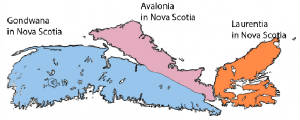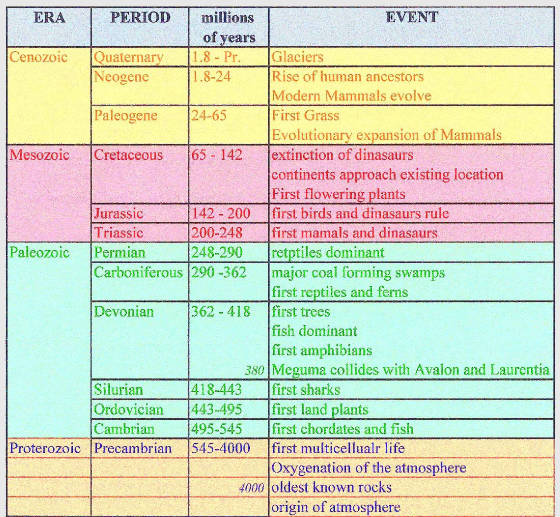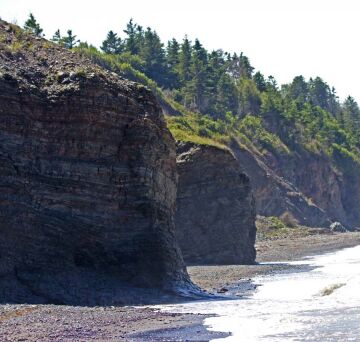|
The underlying contributor.
As you will read below you will come to realise what a wonderful diverse geology Nova Scotia has and why
it contributes so much to the natural world in our province by the sea.

A Very Brief History of a Very Long Time:
Over the last billion or so years, what we now know as
Nova Scotia, has drifted around the globe in three large pieces, only coming together in one final great collision about 380
million years ago. Each of those pieces were parts of larger land masses: Cape Breton was part of an area known as Laurentia, Northern Nova Scotia was part of Avalonia, and the remaining South-Western area was a part of Gondwana. Each area has been significantly changed by volcanoes, mountain building, erosion,
faulting and glaciation. At different times they were sea bottoms, swamps, deserts,
inland lakes, tropical rain forests, and frozen beneath mile high glaciers. Around
300 million years ago Nova
Scotia was attached
to Morocco in Africa. It is no wonder that the geology varies greatly in each of the areas.

|
|
Minerals in Nova Scotia:
Coal and Natural Gas: Over half the electricity generated in Nova Scotia is coal fired. Coal was
formed about 310 million years ago in the Carboniferous Period. The climate was hot and humid, and many lush forests were
in abundance. Repeated flooding periodically killed forests in the lowlands and many layers of dead vegetative matter were
compressed into peat. Over time the peat turned to coal. The further addition of heat broke down the coal into simpler molecules
of natural gas. Oil, found offshore, was a further breakdown of animal and plant
matter into the liquid form.
Gold: Gold is frequently found in Cambrian and Ordovician rocks. Gold bearing granitic magma rises upwards and
is concentrated in veins at the sides and tops of folded rocks. Salmon River deposit at Port Dufferin, Nova Scotia is a good
example of this type of development.
Gypsum, Potash, and Salt: During the Carboniferous Period, dissolved salts from eroding inland rock
were carried by rivers into lakes and seas. In the arid climate, these bodies of water frequently dried up, leaving behind
concentrations of precipitated salts. Eventually, when concentrations were high
enough, crystals formed. Calcium carbonate (limestone) was the first to form. Following, in order of formation, were: calcium
sulphate (gypsum), sodium chloride (salt), and finally potassium chloride (potash). It is interesting to note that orchids in Nova Scotia are frequently found in gypsum rich soils.

|
| Silurian sedimentary deposits. |
Rock Hounding in Nova
Scotia:
Many collecting sites are open
to the public. Fossils and semiprecious rocks are easily found. However, great care must be given to respecting the environment
and private property. Over-collecting has destroyed some sites and others have been closed because of vandalism. It is best
to look, photograph and leave behind for others to find. That being said, some good sites are:
Arisaig: Silurian fossils. Enter at
the provincial park and walk to far end of beach. Picture at right is of
Silurian Sedimentary Deposits
Blue Beach (near Hantsport): Carboniferous
and Permian fossils. Visit the museum.
Ross Creek and Black Hole Bay, Scot’s Cove (Bay of Fundy): agates, opal, jasper and zealites.Visit all the little
beaches in the area.
Parsboro: Attend the rock and gem show in August and visit
the local rock museum. Locals will give directions to good spots.
|




